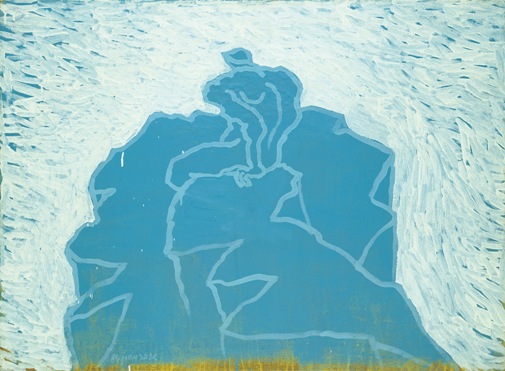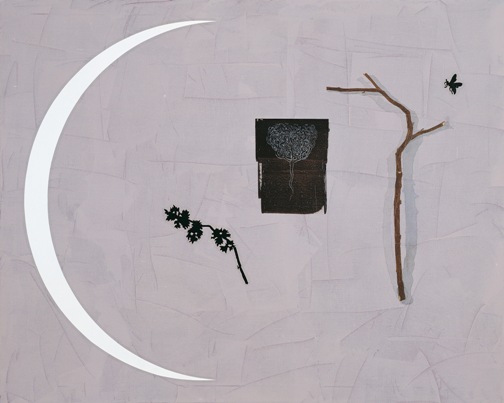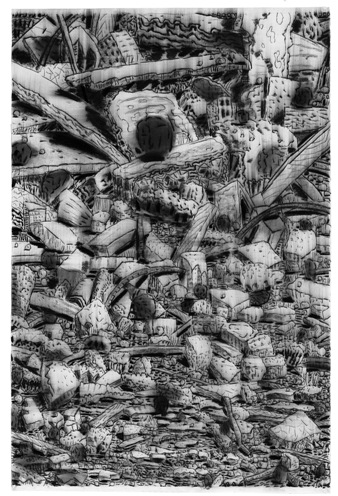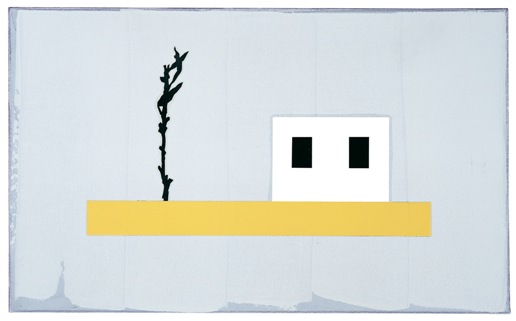
Larry Abramson: Paintings 1975-2010, is an elegant and important exhibition, one of the best offerings this year at the Tel Aviv Museum. Displayed chronologically, a dozen series of paintings are represented, each focusing on a single motif or idea. By this means, curator Ellen Ginton has fully revealed the intellectual breadth and unique style of working that has made Abramson one of this country’s outstanding contemporary painters.
One might say that Abramson’s artistic journey began with Nevo, one of the artist’s earliest collection of paintings. It was inspired by the biblical story of Moses on Mount Nebo looking down with longing onto the Promised Land which God did not permit him to enter. Abramson, born in South Africa, viewed this scene as mirroring his own, as yet unfulfilled, quest to find a way of making art that would be relevant to our times and to the country in which he had chosen to live.
In the freely brushed Nevo paintings Abraham depicts the figure of a man seated astride a mountain peak surrounded by a dark void or swirling lights. In some versions, the ‘way forward’ is guarded by two monumental figures representing the great masters of Modernism: Duchamp (for whom, even a urinal brought into a museum was art,) and Malevitch, painter of the famed Black Square (1915); a seminal image interpreted by some people as sounding the death knell of painting, while others, like Abramson, viewing it as the start of a new spiritual dimension in art.

From the late 1970s onwards, Malevitch’s Square, painted yellow or white, but mostly black, has become a recurrent element in Abramson’s paintings. Ellen Ginton, curator of this show, explains its presence as “an allegory for the state of the artist in late modernism.” What also appears to be true: the Black Square acts as an anchor and reference point for Abramson in his ongoing dialogue with many artists and schools of the past, amongst them realism, romantic and trompe d’oeil painting, minimalism and abstraction.
The radiant Zoreach/Gorea series from 2008 gives full expression to his distinctive painting style, honed over several decades. As in other series, Abramson brings Nature into his studio in the form of twigs, branches and flowering shoots painting them life size and super- realistically. Elements in crisp, minimally ordered compositions, they look as if they are pinned to a pearl-grey wall, but it is just a paint surface that the artist has plastered on with a trowel over a deep violet color field.
Introduced into these spare configurations are other images, among them a strip of paper painted to simulate veneered wood, a cluster of grapes and the Flower of Jericho, a plant needing but a drop of water to bring it back to life. Here too, one finds the cut-out form of a pale sickle moon which in some paintings takes on the appearance of a scythe. In Panic, Abramson’s most recent series, similar objects are rendered in sihouette but also include damaged fruit and insects crawling up the roots of plants.

There is a pessimist message underlying Pile, a set of charcoal drawings (that incidentally demonstrate Abramson’s skills as a draughtsman) produced after he saw Triumph of Death (1944), the last work painted by the German-Jewish artist Felix Nussbaum prior to his capture and death in Auschwitz. This picture depicting the ruins of civilization may itself have been based on a 16th century painting of the same name by Pieter Breughel the Elder depicting a world of evil people. Abramson completed his Pile series one year after 9/11, and two years after the second Intifida brought an end to hopes of peace. Based on photos of a destroyed Jerusalem house, his papers are covered in their entirety with the images of rubble, rocks and forms suggestive of gravestones.
Abramson, a dedicated peace activist, makes a strong statement in his Tsuba series which originated from a photo of the remnants of a Palestinian village in the Judean hills abandoned in 1948. This same location was painted in 1983 by Josef Zaritsky, father of the local movement of lyrical abstract painting. But ignoring the historical-tragic aspect of the site, he had viewed it only as a picturesque starting point for his abstractions. Abramson produced 38 small oil paintings on this theme in which sheets of newsprint applied to wet paint surfaces all but obliterated a view of what had once been a pastoral settlement.

The concept of seeing, or being blind to reality, is given expression in other works by Abramson; for instance, in Eye Witnesses , a set of drawings , and his latest painting series Homes. Here, small houses with blackened windows, balancing on a bar, appear to float on air. A frail plant, either hanging down, or ‘growing’ from this bar, adds to a general impression of instability.
Looking at Abramson’s paintings with their political connotations there is clearly a choice as to what one wants to see and understand, or just enjoy. But the overriding impression is of beautifully judged paintings, transcendental in their beauty and simplicity.
Sam and Ayala Sacks Pavilion
Tel Aviv Museum of Art
Till October 2010
ANGELA LEVINE





